WS4503: Social Work and Mental Health in Aboriginal Australia
VerifiedAdded on 2023/01/03
|9
|2623
|34
Essay
AI Summary
This essay delves into the critical role of social work in the realm of mental health, emphasizing the significance of cultural sensitivity, ethical considerations, and the challenges encountered by social workers, especially within the context of Aboriginal communities in Australia. The essay examines the evolution of mental health practices, including the shift from restrictive approaches to more humanitarian and rights-based models. It highlights the importance of understanding socio-cultural barriers, personal challenges, and the adoption of various social work approaches, such as the Bio-Psycho-Socio model, to address mental health issues holistically. Furthermore, it discusses the impact of colonization, the importance of respecting cultural differences, and the need for social workers to be aware of relevant health policies and ethical guidelines. The essay also explores the role of the Diagnostic and Statistical Manual of Mental Disorders (DSM-5) in addressing substance abuse and inhalant issues within Aboriginal communities, the challenges of building trust and overcoming language barriers, and the various steps involved in the social work process, including preparation, data collection, treatment planning, and the importance of family involvement. The essay concludes by emphasizing the integral role of social workers in bridging societal gaps, ensuring that individuals with mental illnesses can reintegrate into mainstream society and lead fulfilling lives. This assignment is available on Desklib, a platform providing AI-powered study tools.
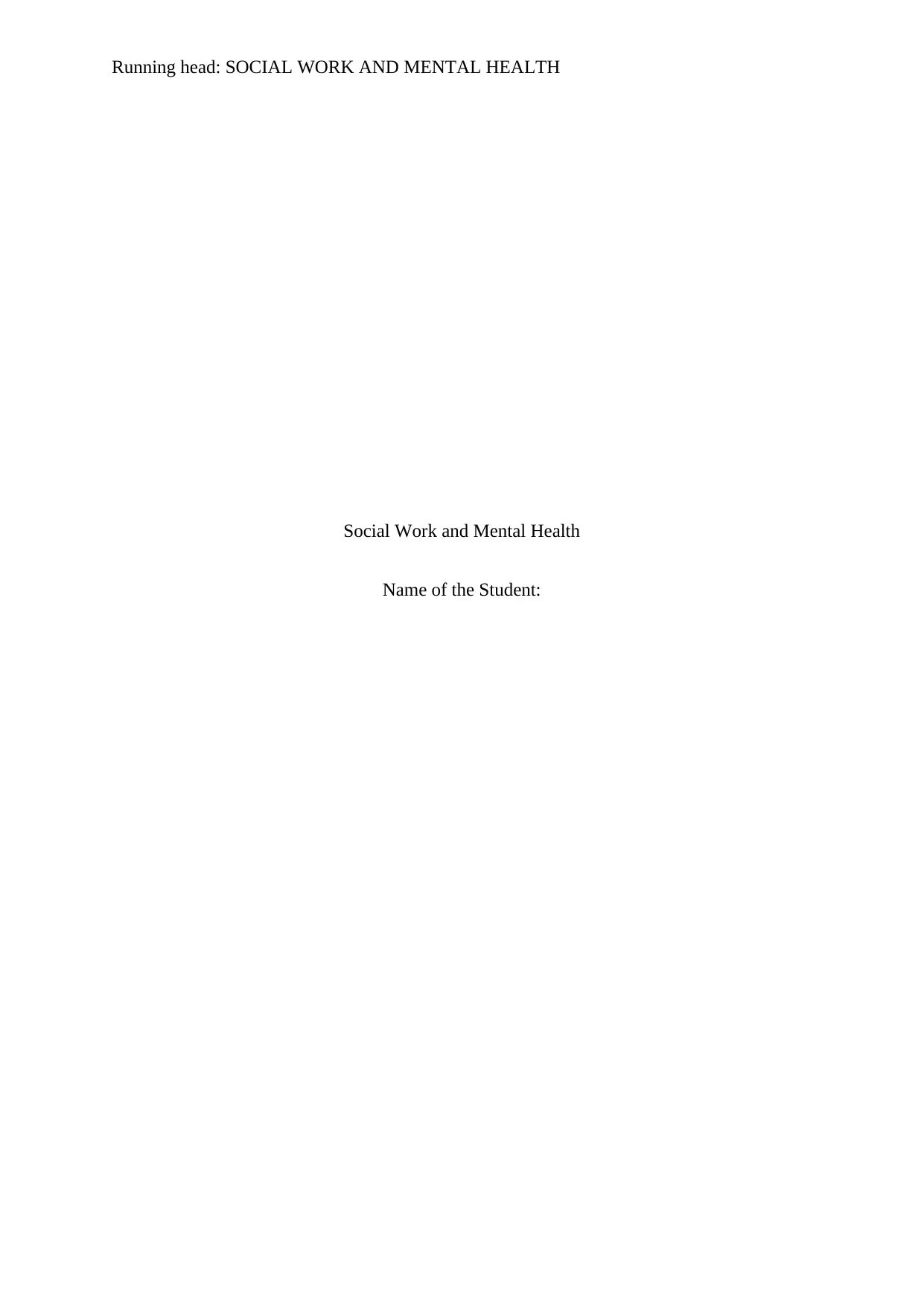
Running head: SOCIAL WORK AND MENTAL HEALTH
Social Work and Mental Health
Name of the Student:
Social Work and Mental Health
Name of the Student:
Paraphrase This Document
Need a fresh take? Get an instant paraphrase of this document with our AI Paraphraser
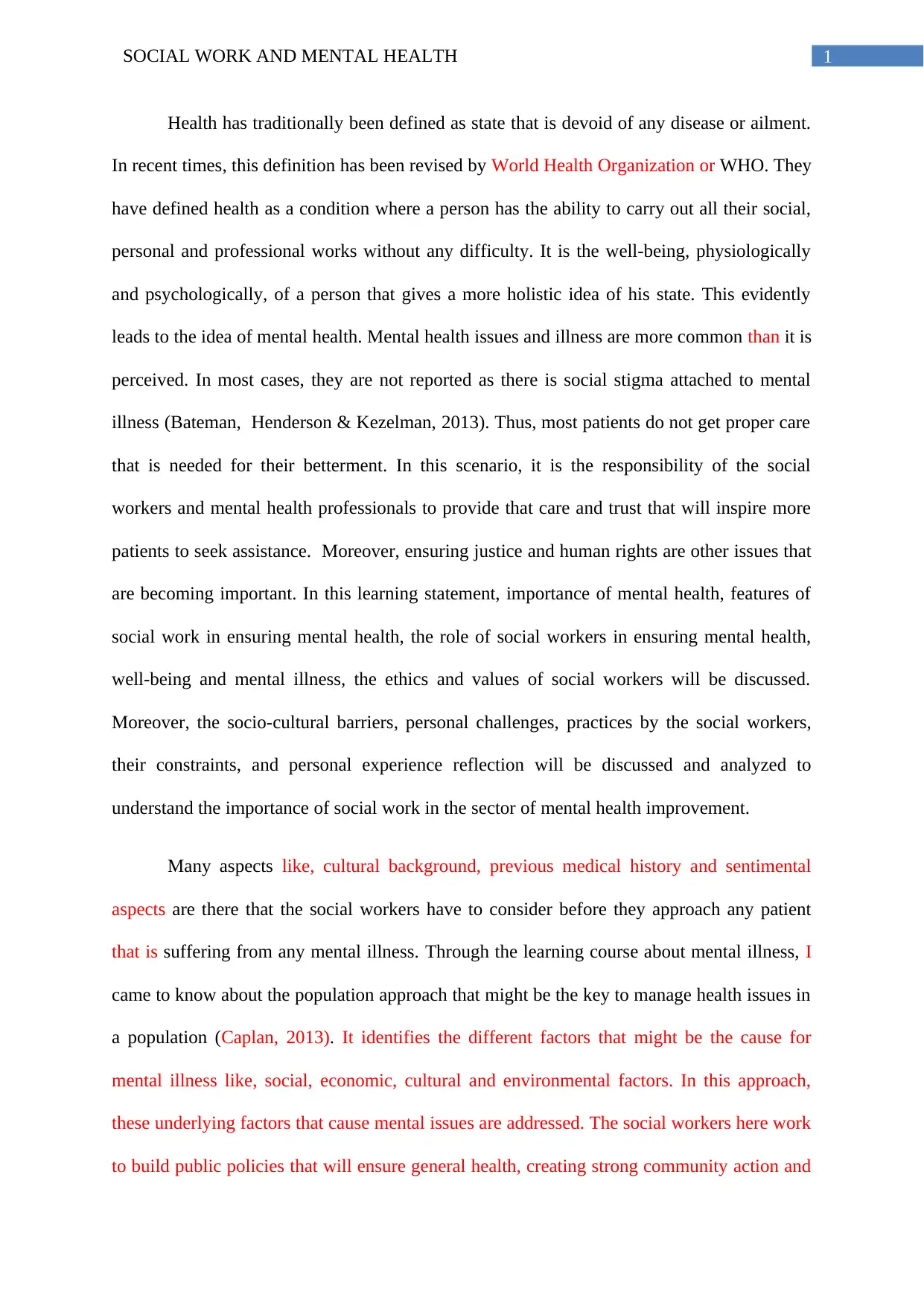
1SOCIAL WORK AND MENTAL HEALTH
Health has traditionally been defined as state that is devoid of any disease or ailment.
In recent times, this definition has been revised by World Health Organization or WHO. They
have defined health as a condition where a person has the ability to carry out all their social,
personal and professional works without any difficulty. It is the well-being, physiologically
and psychologically, of a person that gives a more holistic idea of his state. This evidently
leads to the idea of mental health. Mental health issues and illness are more common than it is
perceived. In most cases, they are not reported as there is social stigma attached to mental
illness (Bateman, Henderson & Kezelman, 2013). Thus, most patients do not get proper care
that is needed for their betterment. In this scenario, it is the responsibility of the social
workers and mental health professionals to provide that care and trust that will inspire more
patients to seek assistance. Moreover, ensuring justice and human rights are other issues that
are becoming important. In this learning statement, importance of mental health, features of
social work in ensuring mental health, the role of social workers in ensuring mental health,
well-being and mental illness, the ethics and values of social workers will be discussed.
Moreover, the socio-cultural barriers, personal challenges, practices by the social workers,
their constraints, and personal experience reflection will be discussed and analyzed to
understand the importance of social work in the sector of mental health improvement.
Many aspects like, cultural background, previous medical history and sentimental
aspects are there that the social workers have to consider before they approach any patient
that is suffering from any mental illness. Through the learning course about mental illness, I
came to know about the population approach that might be the key to manage health issues in
a population (Caplan, 2013). It identifies the different factors that might be the cause for
mental illness like, social, economic, cultural and environmental factors. In this approach,
these underlying factors that cause mental issues are addressed. The social workers here work
to build public policies that will ensure general health, creating strong community action and
Health has traditionally been defined as state that is devoid of any disease or ailment.
In recent times, this definition has been revised by World Health Organization or WHO. They
have defined health as a condition where a person has the ability to carry out all their social,
personal and professional works without any difficulty. It is the well-being, physiologically
and psychologically, of a person that gives a more holistic idea of his state. This evidently
leads to the idea of mental health. Mental health issues and illness are more common than it is
perceived. In most cases, they are not reported as there is social stigma attached to mental
illness (Bateman, Henderson & Kezelman, 2013). Thus, most patients do not get proper care
that is needed for their betterment. In this scenario, it is the responsibility of the social
workers and mental health professionals to provide that care and trust that will inspire more
patients to seek assistance. Moreover, ensuring justice and human rights are other issues that
are becoming important. In this learning statement, importance of mental health, features of
social work in ensuring mental health, the role of social workers in ensuring mental health,
well-being and mental illness, the ethics and values of social workers will be discussed.
Moreover, the socio-cultural barriers, personal challenges, practices by the social workers,
their constraints, and personal experience reflection will be discussed and analyzed to
understand the importance of social work in the sector of mental health improvement.
Many aspects like, cultural background, previous medical history and sentimental
aspects are there that the social workers have to consider before they approach any patient
that is suffering from any mental illness. Through the learning course about mental illness, I
came to know about the population approach that might be the key to manage health issues in
a population (Caplan, 2013). It identifies the different factors that might be the cause for
mental illness like, social, economic, cultural and environmental factors. In this approach,
these underlying factors that cause mental issues are addressed. The social workers here work
to build public policies that will ensure general health, creating strong community action and
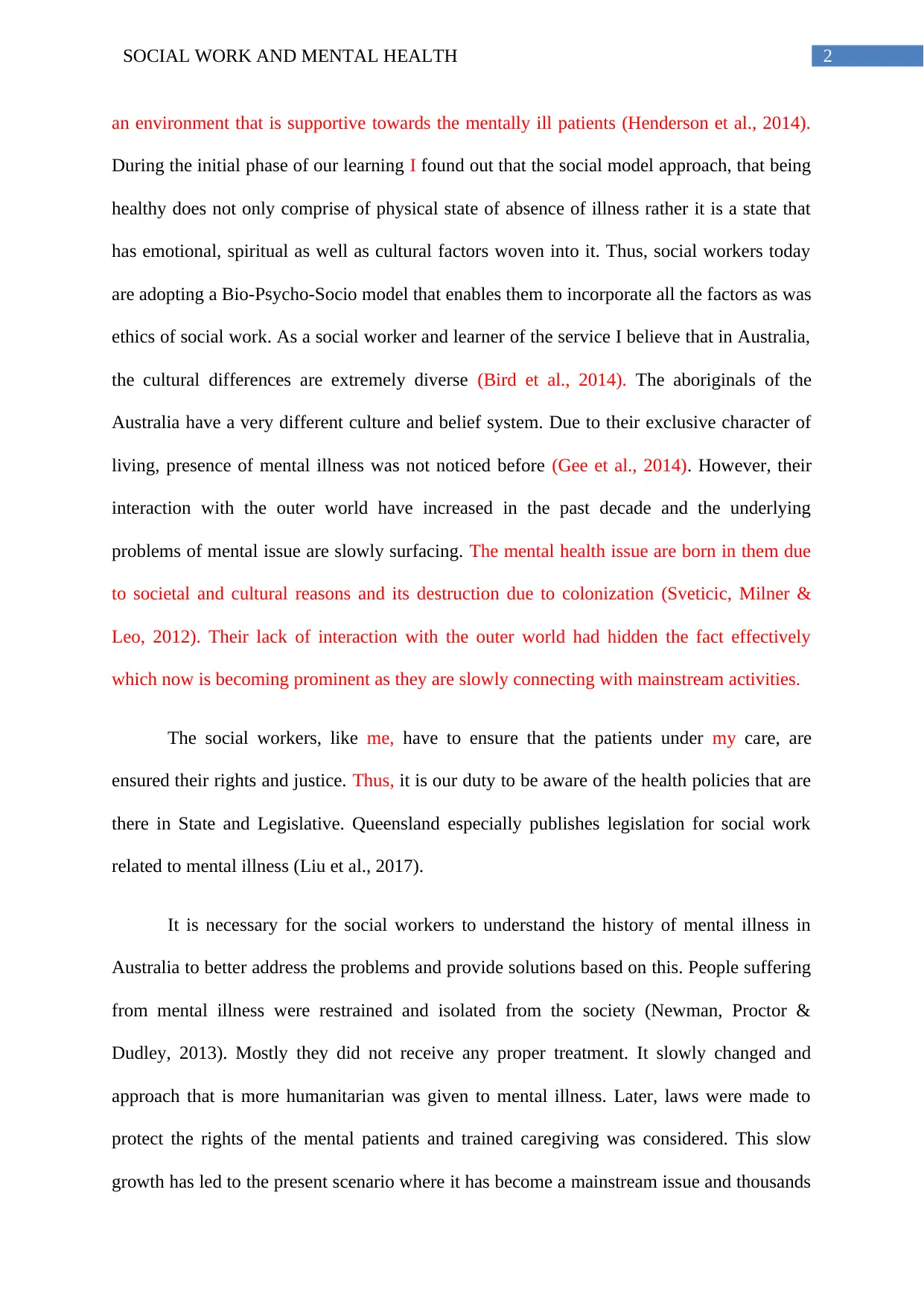
2SOCIAL WORK AND MENTAL HEALTH
an environment that is supportive towards the mentally ill patients (Henderson et al., 2014).
During the initial phase of our learning I found out that the social model approach, that being
healthy does not only comprise of physical state of absence of illness rather it is a state that
has emotional, spiritual as well as cultural factors woven into it. Thus, social workers today
are adopting a Bio-Psycho-Socio model that enables them to incorporate all the factors as was
ethics of social work. As a social worker and learner of the service I believe that in Australia,
the cultural differences are extremely diverse (Bird et al., 2014). The aboriginals of the
Australia have a very different culture and belief system. Due to their exclusive character of
living, presence of mental illness was not noticed before (Gee et al., 2014). However, their
interaction with the outer world have increased in the past decade and the underlying
problems of mental issue are slowly surfacing. The mental health issue are born in them due
to societal and cultural reasons and its destruction due to colonization (Sveticic, Milner &
Leo, 2012). Their lack of interaction with the outer world had hidden the fact effectively
which now is becoming prominent as they are slowly connecting with mainstream activities.
The social workers, like me, have to ensure that the patients under my care, are
ensured their rights and justice. Thus, it is our duty to be aware of the health policies that are
there in State and Legislative. Queensland especially publishes legislation for social work
related to mental illness (Liu et al., 2017).
It is necessary for the social workers to understand the history of mental illness in
Australia to better address the problems and provide solutions based on this. People suffering
from mental illness were restrained and isolated from the society (Newman, Proctor &
Dudley, 2013). Mostly they did not receive any proper treatment. It slowly changed and
approach that is more humanitarian was given to mental illness. Later, laws were made to
protect the rights of the mental patients and trained caregiving was considered. This slow
growth has led to the present scenario where it has become a mainstream issue and thousands
an environment that is supportive towards the mentally ill patients (Henderson et al., 2014).
During the initial phase of our learning I found out that the social model approach, that being
healthy does not only comprise of physical state of absence of illness rather it is a state that
has emotional, spiritual as well as cultural factors woven into it. Thus, social workers today
are adopting a Bio-Psycho-Socio model that enables them to incorporate all the factors as was
ethics of social work. As a social worker and learner of the service I believe that in Australia,
the cultural differences are extremely diverse (Bird et al., 2014). The aboriginals of the
Australia have a very different culture and belief system. Due to their exclusive character of
living, presence of mental illness was not noticed before (Gee et al., 2014). However, their
interaction with the outer world have increased in the past decade and the underlying
problems of mental issue are slowly surfacing. The mental health issue are born in them due
to societal and cultural reasons and its destruction due to colonization (Sveticic, Milner &
Leo, 2012). Their lack of interaction with the outer world had hidden the fact effectively
which now is becoming prominent as they are slowly connecting with mainstream activities.
The social workers, like me, have to ensure that the patients under my care, are
ensured their rights and justice. Thus, it is our duty to be aware of the health policies that are
there in State and Legislative. Queensland especially publishes legislation for social work
related to mental illness (Liu et al., 2017).
It is necessary for the social workers to understand the history of mental illness in
Australia to better address the problems and provide solutions based on this. People suffering
from mental illness were restrained and isolated from the society (Newman, Proctor &
Dudley, 2013). Mostly they did not receive any proper treatment. It slowly changed and
approach that is more humanitarian was given to mental illness. Later, laws were made to
protect the rights of the mental patients and trained caregiving was considered. This slow
growth has led to the present scenario where it has become a mainstream issue and thousands
⊘ This is a preview!⊘
Do you want full access?
Subscribe today to unlock all pages.

Trusted by 1+ million students worldwide
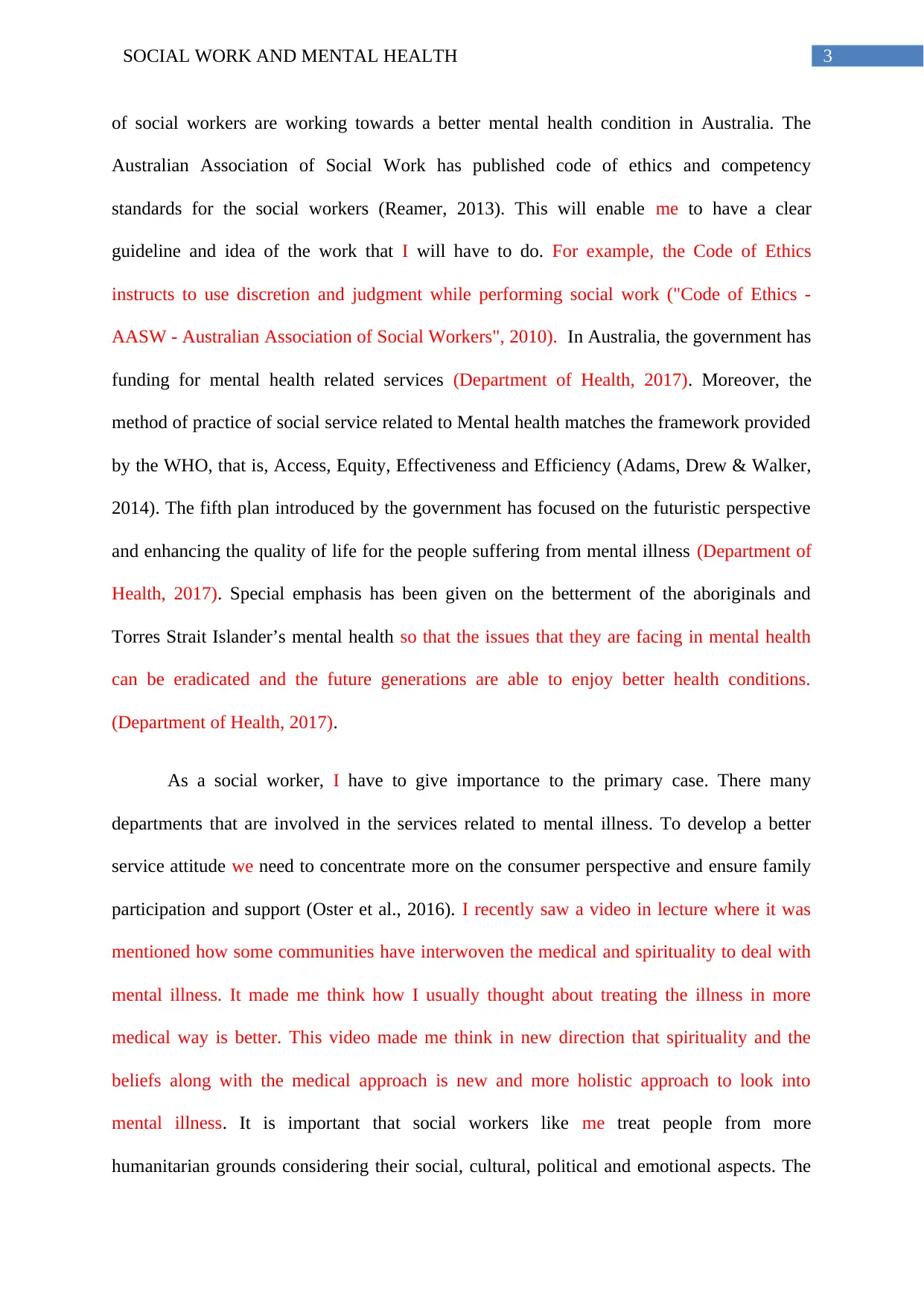
3SOCIAL WORK AND MENTAL HEALTH
of social workers are working towards a better mental health condition in Australia. The
Australian Association of Social Work has published code of ethics and competency
standards for the social workers (Reamer, 2013). This will enable me to have a clear
guideline and idea of the work that I will have to do. For example, the Code of Ethics
instructs to use discretion and judgment while performing social work ("Code of Ethics -
AASW - Australian Association of Social Workers", 2010). In Australia, the government has
funding for mental health related services (Department of Health, 2017). Moreover, the
method of practice of social service related to Mental health matches the framework provided
by the WHO, that is, Access, Equity, Effectiveness and Efficiency (Adams, Drew & Walker,
2014). The fifth plan introduced by the government has focused on the futuristic perspective
and enhancing the quality of life for the people suffering from mental illness (Department of
Health, 2017). Special emphasis has been given on the betterment of the aboriginals and
Torres Strait Islander’s mental health so that the issues that they are facing in mental health
can be eradicated and the future generations are able to enjoy better health conditions.
(Department of Health, 2017).
As a social worker, I have to give importance to the primary case. There many
departments that are involved in the services related to mental illness. To develop a better
service attitude we need to concentrate more on the consumer perspective and ensure family
participation and support (Oster et al., 2016). I recently saw a video in lecture where it was
mentioned how some communities have interwoven the medical and spirituality to deal with
mental illness. It made me think how I usually thought about treating the illness in more
medical way is better. This video made me think in new direction that spirituality and the
beliefs along with the medical approach is new and more holistic approach to look into
mental illness. It is important that social workers like me treat people from more
humanitarian grounds considering their social, cultural, political and emotional aspects. The
of social workers are working towards a better mental health condition in Australia. The
Australian Association of Social Work has published code of ethics and competency
standards for the social workers (Reamer, 2013). This will enable me to have a clear
guideline and idea of the work that I will have to do. For example, the Code of Ethics
instructs to use discretion and judgment while performing social work ("Code of Ethics -
AASW - Australian Association of Social Workers", 2010). In Australia, the government has
funding for mental health related services (Department of Health, 2017). Moreover, the
method of practice of social service related to Mental health matches the framework provided
by the WHO, that is, Access, Equity, Effectiveness and Efficiency (Adams, Drew & Walker,
2014). The fifth plan introduced by the government has focused on the futuristic perspective
and enhancing the quality of life for the people suffering from mental illness (Department of
Health, 2017). Special emphasis has been given on the betterment of the aboriginals and
Torres Strait Islander’s mental health so that the issues that they are facing in mental health
can be eradicated and the future generations are able to enjoy better health conditions.
(Department of Health, 2017).
As a social worker, I have to give importance to the primary case. There many
departments that are involved in the services related to mental illness. To develop a better
service attitude we need to concentrate more on the consumer perspective and ensure family
participation and support (Oster et al., 2016). I recently saw a video in lecture where it was
mentioned how some communities have interwoven the medical and spirituality to deal with
mental illness. It made me think how I usually thought about treating the illness in more
medical way is better. This video made me think in new direction that spirituality and the
beliefs along with the medical approach is new and more holistic approach to look into
mental illness. It is important that social workers like me treat people from more
humanitarian grounds considering their social, cultural, political and emotional aspects. The
Paraphrase This Document
Need a fresh take? Get an instant paraphrase of this document with our AI Paraphraser
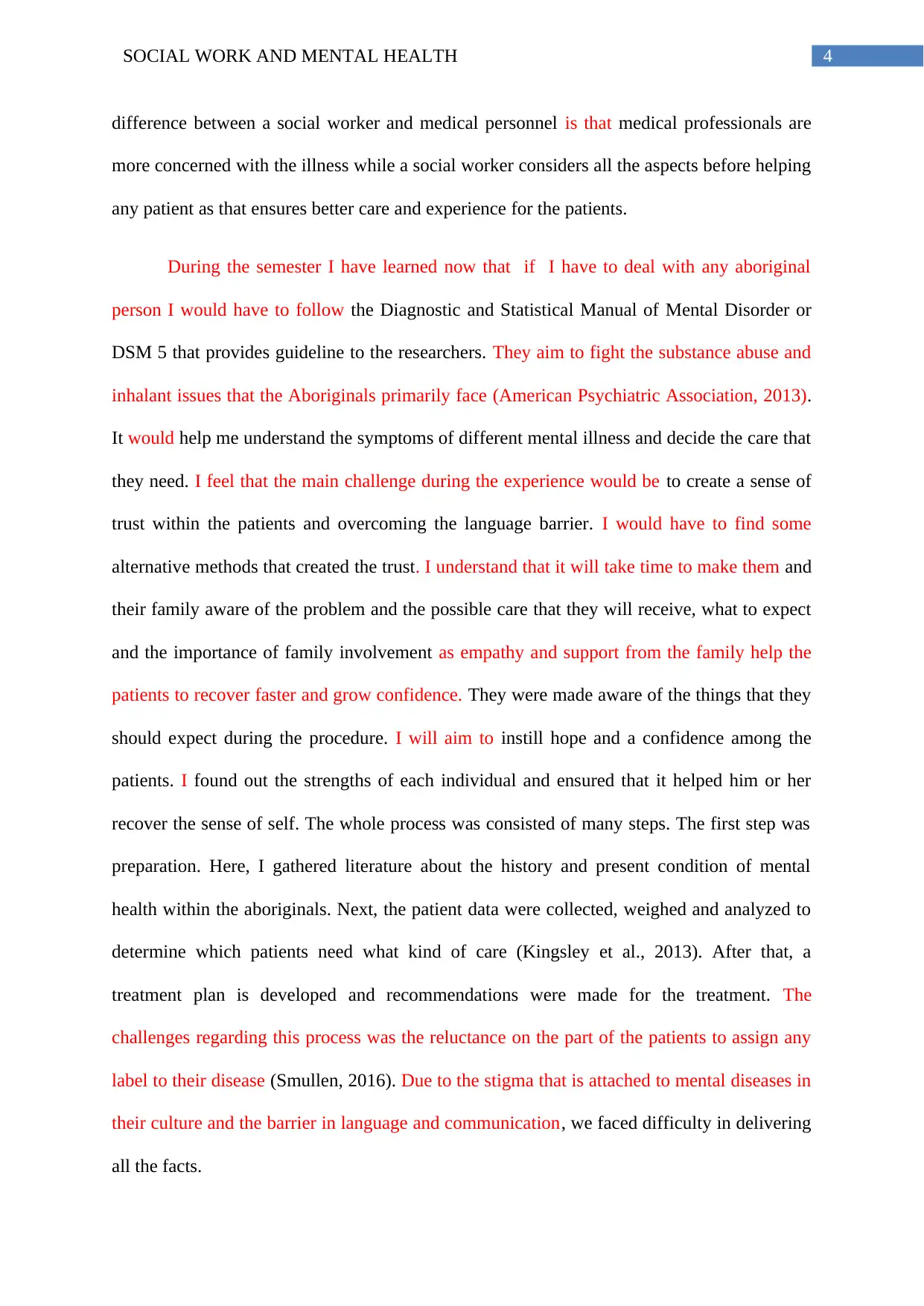
4SOCIAL WORK AND MENTAL HEALTH
difference between a social worker and medical personnel is that medical professionals are
more concerned with the illness while a social worker considers all the aspects before helping
any patient as that ensures better care and experience for the patients.
During the semester I have learned now that if I have to deal with any aboriginal
person I would have to follow the Diagnostic and Statistical Manual of Mental Disorder or
DSM 5 that provides guideline to the researchers. They aim to fight the substance abuse and
inhalant issues that the Aboriginals primarily face (American Psychiatric Association, 2013).
It would help me understand the symptoms of different mental illness and decide the care that
they need. I feel that the main challenge during the experience would be to create a sense of
trust within the patients and overcoming the language barrier. I would have to find some
alternative methods that created the trust. I understand that it will take time to make them and
their family aware of the problem and the possible care that they will receive, what to expect
and the importance of family involvement as empathy and support from the family help the
patients to recover faster and grow confidence. They were made aware of the things that they
should expect during the procedure. I will aim to instill hope and a confidence among the
patients. I found out the strengths of each individual and ensured that it helped him or her
recover the sense of self. The whole process was consisted of many steps. The first step was
preparation. Here, I gathered literature about the history and present condition of mental
health within the aboriginals. Next, the patient data were collected, weighed and analyzed to
determine which patients need what kind of care (Kingsley et al., 2013). After that, a
treatment plan is developed and recommendations were made for the treatment. The
challenges regarding this process was the reluctance on the part of the patients to assign any
label to their disease (Smullen, 2016). Due to the stigma that is attached to mental diseases in
their culture and the barrier in language and communication, we faced difficulty in delivering
all the facts.
difference between a social worker and medical personnel is that medical professionals are
more concerned with the illness while a social worker considers all the aspects before helping
any patient as that ensures better care and experience for the patients.
During the semester I have learned now that if I have to deal with any aboriginal
person I would have to follow the Diagnostic and Statistical Manual of Mental Disorder or
DSM 5 that provides guideline to the researchers. They aim to fight the substance abuse and
inhalant issues that the Aboriginals primarily face (American Psychiatric Association, 2013).
It would help me understand the symptoms of different mental illness and decide the care that
they need. I feel that the main challenge during the experience would be to create a sense of
trust within the patients and overcoming the language barrier. I would have to find some
alternative methods that created the trust. I understand that it will take time to make them and
their family aware of the problem and the possible care that they will receive, what to expect
and the importance of family involvement as empathy and support from the family help the
patients to recover faster and grow confidence. They were made aware of the things that they
should expect during the procedure. I will aim to instill hope and a confidence among the
patients. I found out the strengths of each individual and ensured that it helped him or her
recover the sense of self. The whole process was consisted of many steps. The first step was
preparation. Here, I gathered literature about the history and present condition of mental
health within the aboriginals. Next, the patient data were collected, weighed and analyzed to
determine which patients need what kind of care (Kingsley et al., 2013). After that, a
treatment plan is developed and recommendations were made for the treatment. The
challenges regarding this process was the reluctance on the part of the patients to assign any
label to their disease (Smullen, 2016). Due to the stigma that is attached to mental diseases in
their culture and the barrier in language and communication, we faced difficulty in delivering
all the facts.
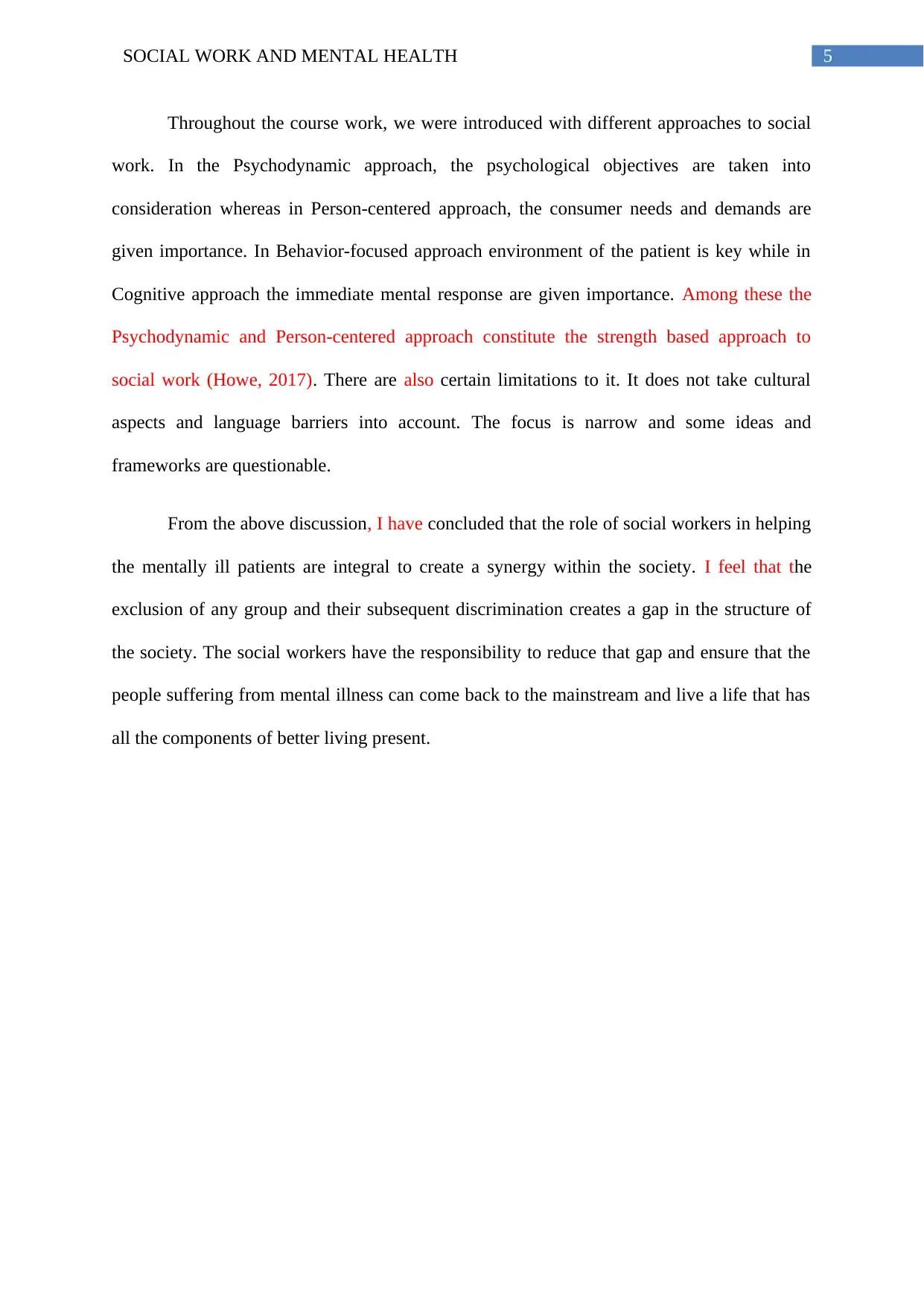
5SOCIAL WORK AND MENTAL HEALTH
Throughout the course work, we were introduced with different approaches to social
work. In the Psychodynamic approach, the psychological objectives are taken into
consideration whereas in Person-centered approach, the consumer needs and demands are
given importance. In Behavior-focused approach environment of the patient is key while in
Cognitive approach the immediate mental response are given importance. Among these the
Psychodynamic and Person-centered approach constitute the strength based approach to
social work (Howe, 2017). There are also certain limitations to it. It does not take cultural
aspects and language barriers into account. The focus is narrow and some ideas and
frameworks are questionable.
From the above discussion, I have concluded that the role of social workers in helping
the mentally ill patients are integral to create a synergy within the society. I feel that the
exclusion of any group and their subsequent discrimination creates a gap in the structure of
the society. The social workers have the responsibility to reduce that gap and ensure that the
people suffering from mental illness can come back to the mainstream and live a life that has
all the components of better living present.
Throughout the course work, we were introduced with different approaches to social
work. In the Psychodynamic approach, the psychological objectives are taken into
consideration whereas in Person-centered approach, the consumer needs and demands are
given importance. In Behavior-focused approach environment of the patient is key while in
Cognitive approach the immediate mental response are given importance. Among these the
Psychodynamic and Person-centered approach constitute the strength based approach to
social work (Howe, 2017). There are also certain limitations to it. It does not take cultural
aspects and language barriers into account. The focus is narrow and some ideas and
frameworks are questionable.
From the above discussion, I have concluded that the role of social workers in helping
the mentally ill patients are integral to create a synergy within the society. I feel that the
exclusion of any group and their subsequent discrimination creates a gap in the structure of
the society. The social workers have the responsibility to reduce that gap and ensure that the
people suffering from mental illness can come back to the mainstream and live a life that has
all the components of better living present.
⊘ This is a preview!⊘
Do you want full access?
Subscribe today to unlock all pages.

Trusted by 1+ million students worldwide
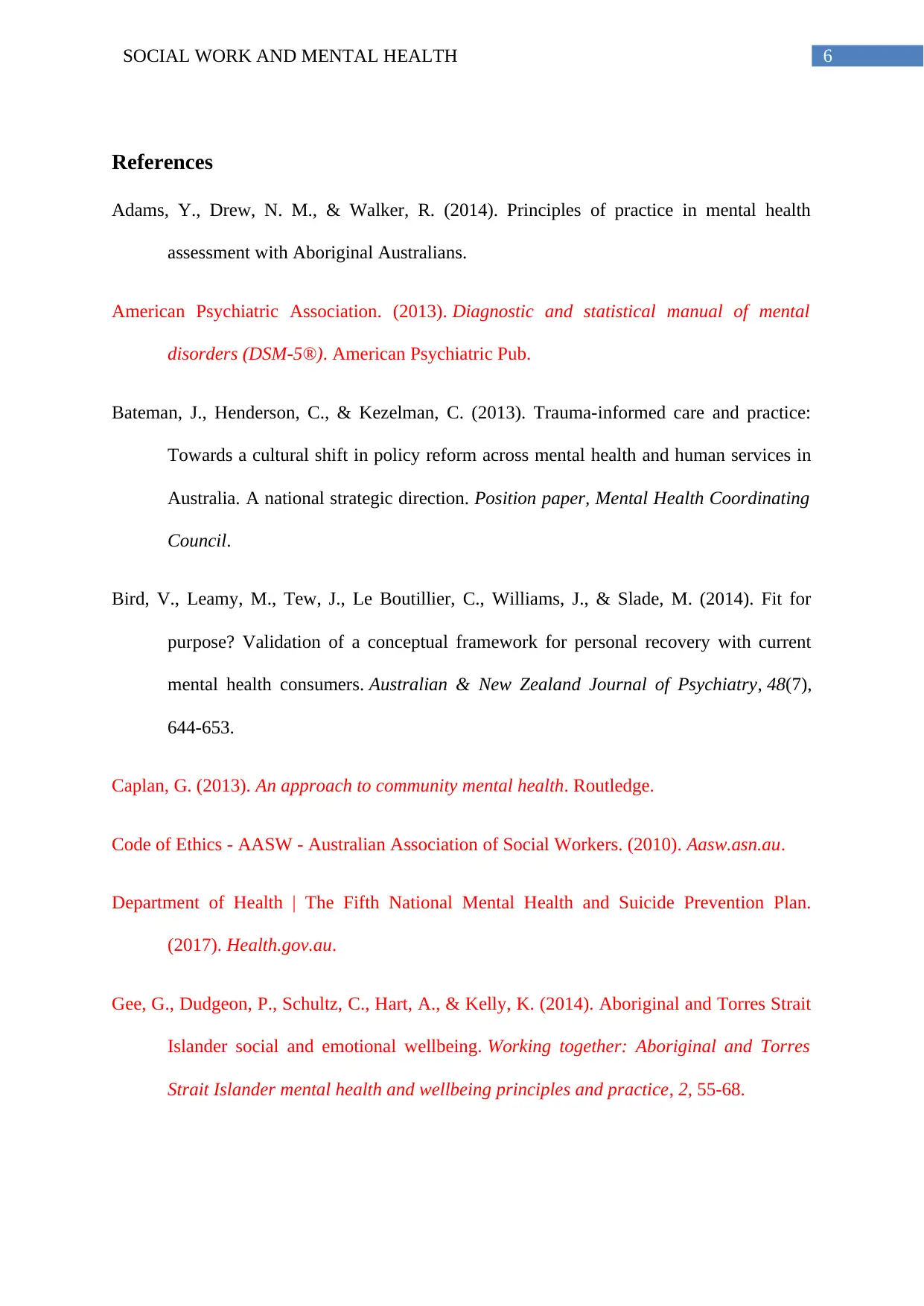
6SOCIAL WORK AND MENTAL HEALTH
References
Adams, Y., Drew, N. M., & Walker, R. (2014). Principles of practice in mental health
assessment with Aboriginal Australians.
American Psychiatric Association. (2013). Diagnostic and statistical manual of mental
disorders (DSM-5®). American Psychiatric Pub.
Bateman, J., Henderson, C., & Kezelman, C. (2013). Trauma-informed care and practice:
Towards a cultural shift in policy reform across mental health and human services in
Australia. A national strategic direction. Position paper, Mental Health Coordinating
Council.
Bird, V., Leamy, M., Tew, J., Le Boutillier, C., Williams, J., & Slade, M. (2014). Fit for
purpose? Validation of a conceptual framework for personal recovery with current
mental health consumers. Australian & New Zealand Journal of Psychiatry, 48(7),
644-653.
Caplan, G. (2013). An approach to community mental health. Routledge.
Code of Ethics - AASW - Australian Association of Social Workers. (2010). Aasw.asn.au.
Department of Health | The Fifth National Mental Health and Suicide Prevention Plan.
(2017). Health.gov.au.
Gee, G., Dudgeon, P., Schultz, C., Hart, A., & Kelly, K. (2014). Aboriginal and Torres Strait
Islander social and emotional wellbeing. Working together: Aboriginal and Torres
Strait Islander mental health and wellbeing principles and practice, 2, 55-68.
References
Adams, Y., Drew, N. M., & Walker, R. (2014). Principles of practice in mental health
assessment with Aboriginal Australians.
American Psychiatric Association. (2013). Diagnostic and statistical manual of mental
disorders (DSM-5®). American Psychiatric Pub.
Bateman, J., Henderson, C., & Kezelman, C. (2013). Trauma-informed care and practice:
Towards a cultural shift in policy reform across mental health and human services in
Australia. A national strategic direction. Position paper, Mental Health Coordinating
Council.
Bird, V., Leamy, M., Tew, J., Le Boutillier, C., Williams, J., & Slade, M. (2014). Fit for
purpose? Validation of a conceptual framework for personal recovery with current
mental health consumers. Australian & New Zealand Journal of Psychiatry, 48(7),
644-653.
Caplan, G. (2013). An approach to community mental health. Routledge.
Code of Ethics - AASW - Australian Association of Social Workers. (2010). Aasw.asn.au.
Department of Health | The Fifth National Mental Health and Suicide Prevention Plan.
(2017). Health.gov.au.
Gee, G., Dudgeon, P., Schultz, C., Hart, A., & Kelly, K. (2014). Aboriginal and Torres Strait
Islander social and emotional wellbeing. Working together: Aboriginal and Torres
Strait Islander mental health and wellbeing principles and practice, 2, 55-68.
Paraphrase This Document
Need a fresh take? Get an instant paraphrase of this document with our AI Paraphraser
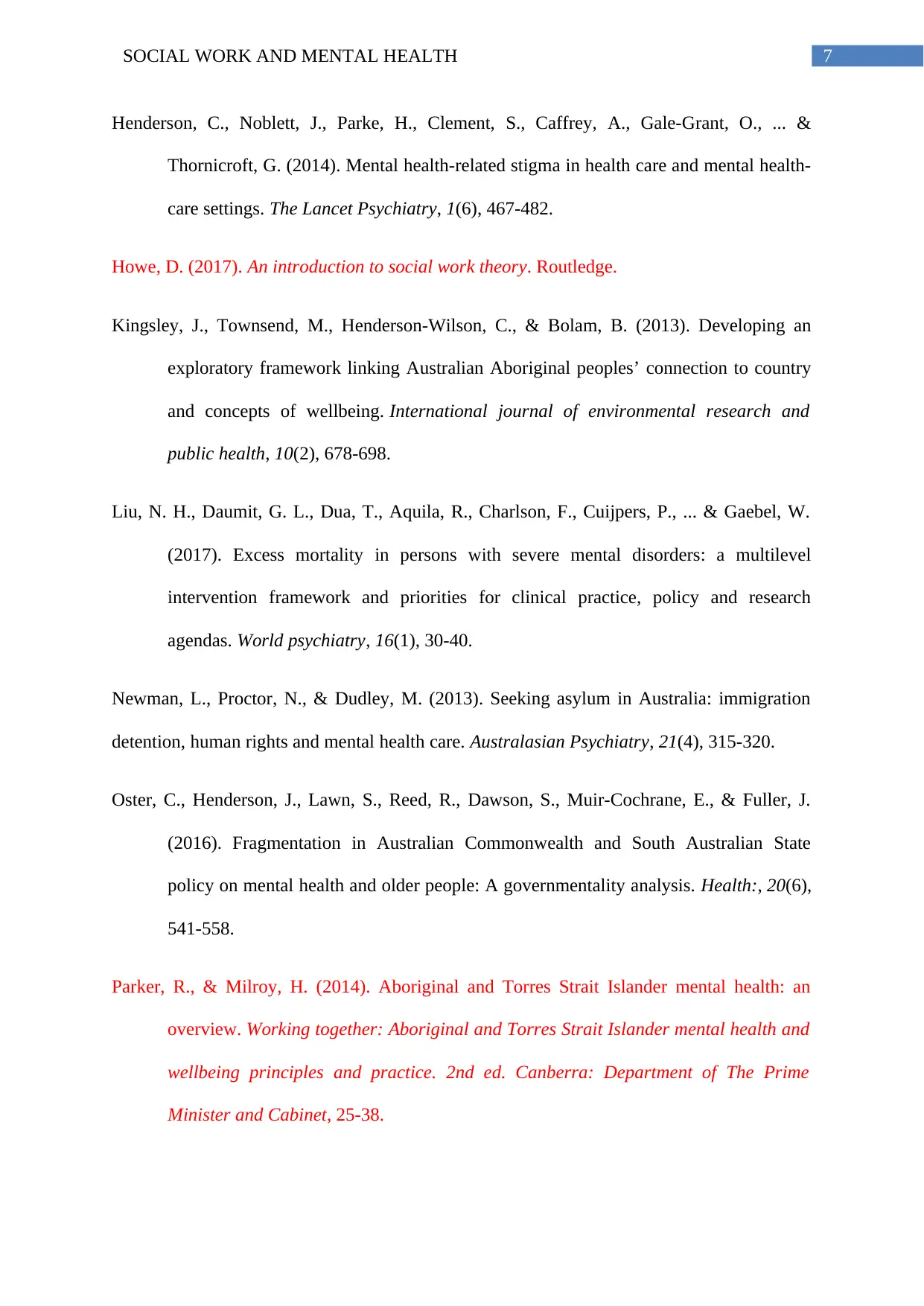
7SOCIAL WORK AND MENTAL HEALTH
Henderson, C., Noblett, J., Parke, H., Clement, S., Caffrey, A., Gale-Grant, O., ... &
Thornicroft, G. (2014). Mental health-related stigma in health care and mental health-
care settings. The Lancet Psychiatry, 1(6), 467-482.
Howe, D. (2017). An introduction to social work theory. Routledge.
Kingsley, J., Townsend, M., Henderson-Wilson, C., & Bolam, B. (2013). Developing an
exploratory framework linking Australian Aboriginal peoples’ connection to country
and concepts of wellbeing. International journal of environmental research and
public health, 10(2), 678-698.
Liu, N. H., Daumit, G. L., Dua, T., Aquila, R., Charlson, F., Cuijpers, P., ... & Gaebel, W.
(2017). Excess mortality in persons with severe mental disorders: a multilevel
intervention framework and priorities for clinical practice, policy and research
agendas. World psychiatry, 16(1), 30-40.
Newman, L., Proctor, N., & Dudley, M. (2013). Seeking asylum in Australia: immigration
detention, human rights and mental health care. Australasian Psychiatry, 21(4), 315-320.
Oster, C., Henderson, J., Lawn, S., Reed, R., Dawson, S., Muir-Cochrane, E., & Fuller, J.
(2016). Fragmentation in Australian Commonwealth and South Australian State
policy on mental health and older people: A governmentality analysis. Health:, 20(6),
541-558.
Parker, R., & Milroy, H. (2014). Aboriginal and Torres Strait Islander mental health: an
overview. Working together: Aboriginal and Torres Strait Islander mental health and
wellbeing principles and practice. 2nd ed. Canberra: Department of The Prime
Minister and Cabinet, 25-38.
Henderson, C., Noblett, J., Parke, H., Clement, S., Caffrey, A., Gale-Grant, O., ... &
Thornicroft, G. (2014). Mental health-related stigma in health care and mental health-
care settings. The Lancet Psychiatry, 1(6), 467-482.
Howe, D. (2017). An introduction to social work theory. Routledge.
Kingsley, J., Townsend, M., Henderson-Wilson, C., & Bolam, B. (2013). Developing an
exploratory framework linking Australian Aboriginal peoples’ connection to country
and concepts of wellbeing. International journal of environmental research and
public health, 10(2), 678-698.
Liu, N. H., Daumit, G. L., Dua, T., Aquila, R., Charlson, F., Cuijpers, P., ... & Gaebel, W.
(2017). Excess mortality in persons with severe mental disorders: a multilevel
intervention framework and priorities for clinical practice, policy and research
agendas. World psychiatry, 16(1), 30-40.
Newman, L., Proctor, N., & Dudley, M. (2013). Seeking asylum in Australia: immigration
detention, human rights and mental health care. Australasian Psychiatry, 21(4), 315-320.
Oster, C., Henderson, J., Lawn, S., Reed, R., Dawson, S., Muir-Cochrane, E., & Fuller, J.
(2016). Fragmentation in Australian Commonwealth and South Australian State
policy on mental health and older people: A governmentality analysis. Health:, 20(6),
541-558.
Parker, R., & Milroy, H. (2014). Aboriginal and Torres Strait Islander mental health: an
overview. Working together: Aboriginal and Torres Strait Islander mental health and
wellbeing principles and practice. 2nd ed. Canberra: Department of The Prime
Minister and Cabinet, 25-38.
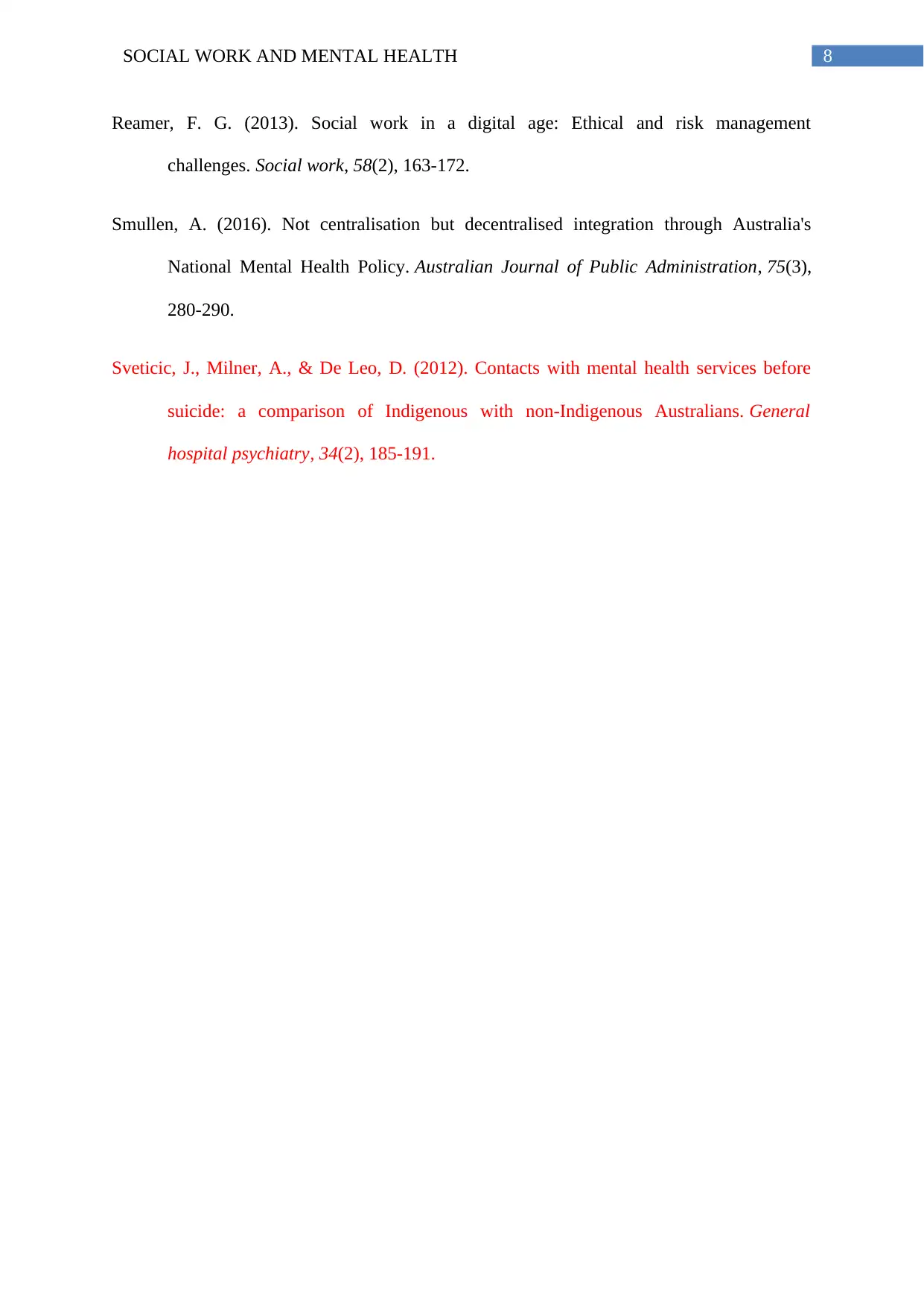
8SOCIAL WORK AND MENTAL HEALTH
Reamer, F. G. (2013). Social work in a digital age: Ethical and risk management
challenges. Social work, 58(2), 163-172.
Smullen, A. (2016). Not centralisation but decentralised integration through Australia's
National Mental Health Policy. Australian Journal of Public Administration, 75(3),
280-290.
Sveticic, J., Milner, A., & De Leo, D. (2012). Contacts with mental health services before
suicide: a comparison of Indigenous with non-Indigenous Australians. General
hospital psychiatry, 34(2), 185-191.
Reamer, F. G. (2013). Social work in a digital age: Ethical and risk management
challenges. Social work, 58(2), 163-172.
Smullen, A. (2016). Not centralisation but decentralised integration through Australia's
National Mental Health Policy. Australian Journal of Public Administration, 75(3),
280-290.
Sveticic, J., Milner, A., & De Leo, D. (2012). Contacts with mental health services before
suicide: a comparison of Indigenous with non-Indigenous Australians. General
hospital psychiatry, 34(2), 185-191.
⊘ This is a preview!⊘
Do you want full access?
Subscribe today to unlock all pages.

Trusted by 1+ million students worldwide
1 out of 9
Related Documents
Your All-in-One AI-Powered Toolkit for Academic Success.
+13062052269
info@desklib.com
Available 24*7 on WhatsApp / Email
![[object Object]](/_next/static/media/star-bottom.7253800d.svg)
Unlock your academic potential
Copyright © 2020–2025 A2Z Services. All Rights Reserved. Developed and managed by ZUCOL.





